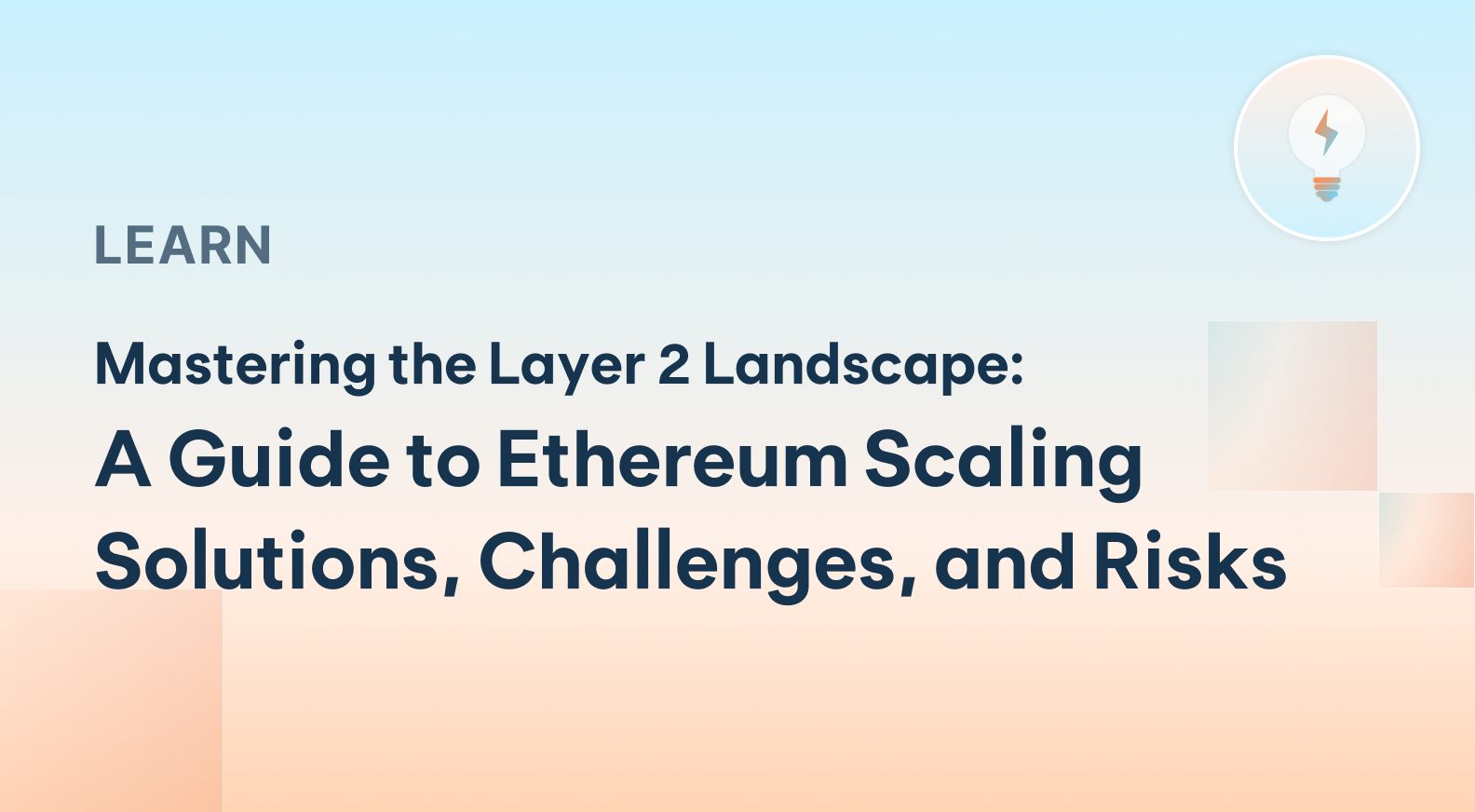Mastering the Layer 2 Landscape: A Guide to Ethereum Scaling Solutions, Challenges, and Risks

Layer 2 (L2) scaling technologies are the hottest topic in Ethereum development right now. These solutions aim to improve blockchain networks' performance regarding transaction throughput, speed, and cost. They operate on top of the base layer (Ethereum Mainnet), enabling transactions and smart contract executions on a separate chain while leveraging the underlying blockchain's security and decentralization. In this post, we aim to inform you about the challenges and risks associated with the benefits of L2. By becoming aware and understanding these risks, you can take the first step towards maximizing the advantages offered by L2.
The Benefits of Layer 2
By moving transactions and computations off the main chain, L2 solutions can reduce network congestion, lower transaction fees, and improve user experience. In summary, the benefits are:
- Enjoy Faster Transactions: L2 scaling solutions enable you to process more transactions per second, reducing network congestion and delivering a smoother experience. Feel the difference in efficiency when using decentralized applications (dApps) with L2!
- Save on Costs with Lower Fees: L2 solutions help you save by offloading transactions from the main chain, resulting in significantly lower fees. Experience the affordability and accessibility of using dApps with L2 without breaking the bank.
- Faster confirmation times: Transactions on L2 solutions can be confirmed by the l2 more quickly than on the main chain, providing a better user experience. Although such confirmations are not final until the Ethereum mainnet is finalized, the user experience is still improved
The Different Types of Layer 2
But not everything that glitters is gold. As with all new technologies, some challenges must be addressed. Our friends from L2Beat have done an amazing job explaining these challenges and limitations.
First, we need to understand that there are many types of L2 solutions. The main one you might be familiar with is Rollup.
As the name implies, rollups bundle (or roll-up) multiple transactions into one. By doing this, they distribute the cost of the L1 transaction among hundreds of L2 transactions, making it cheaper. These transactions do not happen on layer 1, but the transaction data is posted.
To validate such transactions, there are 2 main ways:
- Validity proofs, used by zero-knowledge rollups, such as Zksync
- Fraud proofs are used by optimistic rollups, such as Optimism and Arbitrum.
Navigating the Challenges and Choices in Layer 2's
There are many implementations among rollups, and not all have the same security level or are at the same stage of development. In all cases, substantial design differences and risks pose a question for users: how do I navigate all this? What are the risks?
How L2Beat Can Help You in Assessing Risk: When we visit L2Beat, we can see five main risk categories.
Let's take a look at what each category means
- State validation: The validation method involves how transactions are proven. This could be either with Zero Knowledge (ZK) proofs, which might be slower but offer higher security, or fraud proofs, which are faster and used in systems like Optimistic rollups. Optimistic rollups are called 'optimistic' because they assume all transactions are valid unless proven otherwise. This leads to a crucial question: Are you ready to prioritize security over speed? Or do you need your transactions to be processed more swiftly, even if it might involve a slight compromise on security?
- Data availability: This is about verifying transaction data on the network. Some L2 solutions post this data on Ethereum, while others do not, which could affect your level of trust and risk when you want to exit the L2. You must decide whether you're comfortable relying solely on Ethereum or trusting another entity.
- Upgradability refers to modifying smart contracts to fix bugs, improve, or respond quickly to potential security issues. However, changes can also introduce risks, so it's important to consider how comfortable you are with potential delays and the steps taken to minimize negative impacts.
- Sequencer Failure and Validator Failure: This relates to the reliability of the entities responsible for compiling and sending transactions to Ethereum. If a single entity, called a sequencer, performs this role, there can be risks of bias, censorship, or failure due to downtime. Some L2 solutions provide a backup system to minimize these risks, but this also has its own challenges. Are you willing to accept the risks of a single sequencer, or do you prefer solutions with backup functionality and ongoing research into sequencer decentralization?
The map of scaling solutions doesn't end there. As they grow, some new challenges appear as these solutions compete with each other:
- Liquidity fragmentation: If multiple L2 solutions gain traction, liquidity becomes fragmented across different platforms, making it more difficult for users to access and trade assets.
- User experience complexity: Navigating between L1 and L2 solutions, as well as among various L2 solutions, can be confusing and complicated for users, potentially hindering adoption. Utilizing bridges to move funds around is a jarring experience with multiple steps, and understanding which chain each app exists on takes a lot of time.
- Adoption barriers: L2 solutions require developers and users to adopt and integrate new technologies into their applications and workflows. This can be slow and challenging, limiting the overall effectiveness of L2 scaling solutions.
Note: Another risk not explicitly mentioned here is software errors. Rollups are smart contracts; like all smart contracts and software, they could have bugs and errors. Such vulnerabilities could lead to loss of funds. Even the best audits can't discover all bugs; generally, being deployed for a long time without errors is a good indicator of being bug-free.
In conclusion, Layer 2 scaling solutions offer promising benefits such as increased throughput, lower transaction fees, and faster confirmation times, significantly enhancing the user experience on the Ethereum network. However, it's essential to be aware of the challenges and risks associated with these solutions, including state validation, data availability, upgradability, sequencer and validator failure, liquidity fragmentation, user experience complexity, and adoption barriers.
Tools like L2Beat can help users assess risks and make informed decisions when choosing an L2 solution. Additionally, it's crucial to consider the track record of the smart contracts involved, as longer deployment times without errors can indicate a higher level of reliability.
Visit L2Beat: https://l2beat.com/scaling/tvl
As the Ethereum ecosystem continues to evolve and innovate, Layer 2 scaling solutions will likely mature and address many of these challenges, ultimately paving the way for more widespread adoption of decentralized applications and realizing blockchain's full potential. Staying informed and educated about these advancements is key to navigating the rapidly changing landscape and making the most of the exciting opportunities that lie ahead.
Getting help
If you have any questions regarding Summer.fi in general, you contact us at support@summer.fi or on our social media.

